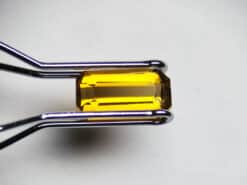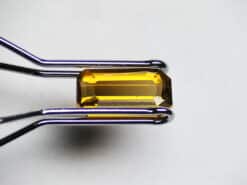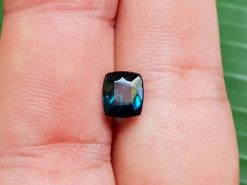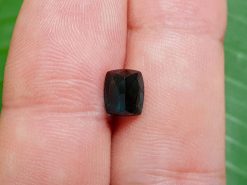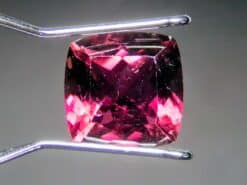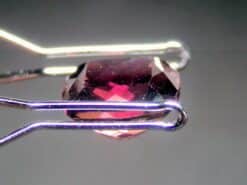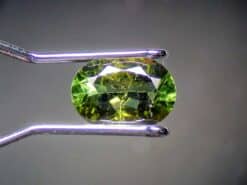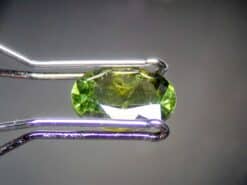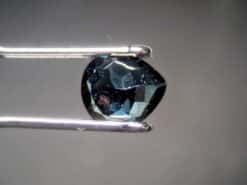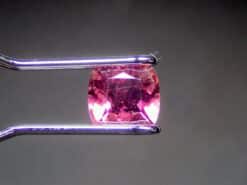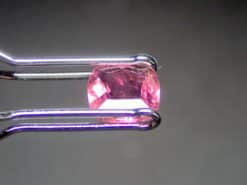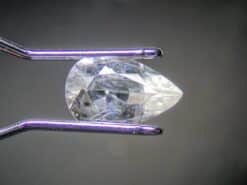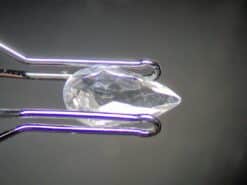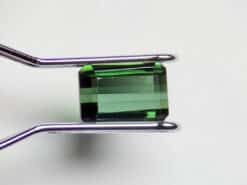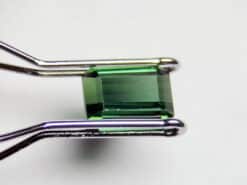Tourmaline
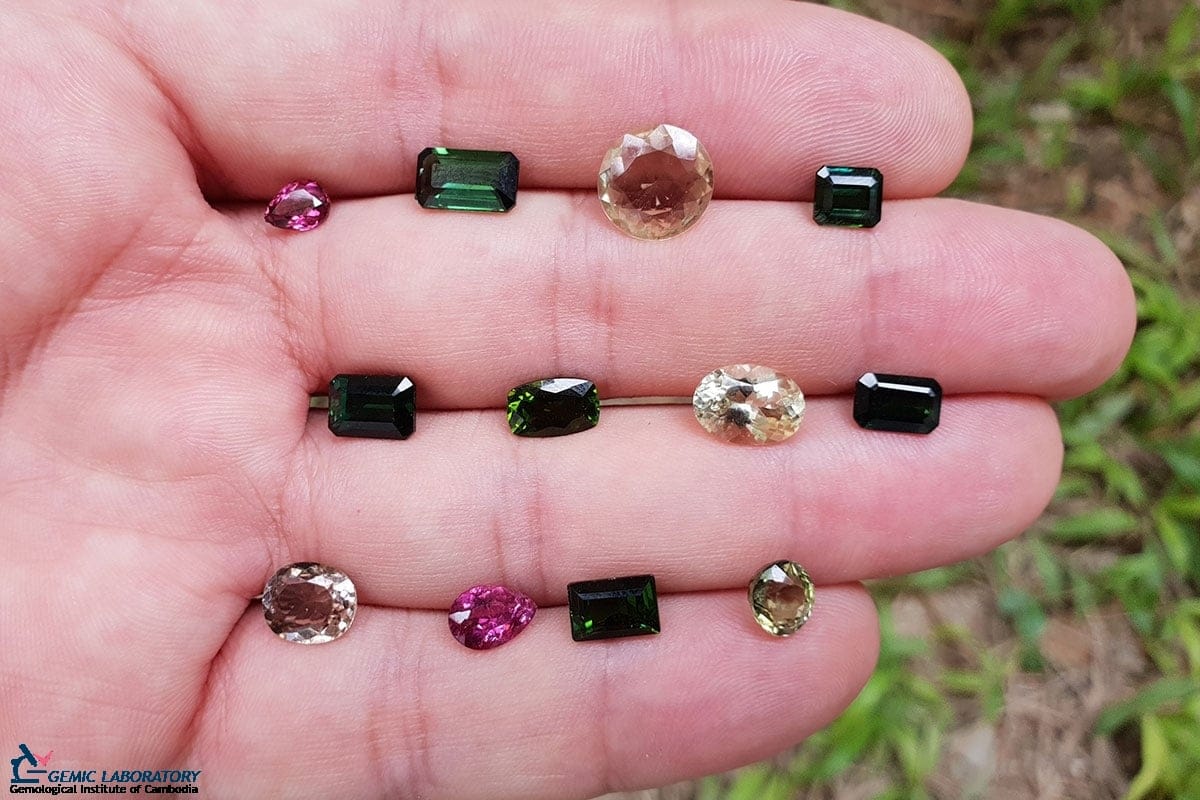
We create custom jewelry pieces featuring natural color tourmaline gemstones or elbaite stones, including necklaces, rings, earrings, bracelets, and pendants. Every piece is carefully crafted to highlight the unique hues and qualities of this remarkable mineral.
Buy natural tourmaline in our shop
Tourmaline is a crystalline boron silicate mineral that often contains trace elements such as aluminum, iron, magnesium, sodium, lithium, or potassium. Classified as a semi-precious gemstone, it is renowned for its remarkable variety of colors, ranging from subtle pastels to vibrant and intense shades. Thanks to its durability, tourmaline is highly valued by both collectors and jewelry enthusiasts who appreciate its combination of beauty, versatility, and relative hardness.
Elbaite
Elbaite is one of the most sought-after members of the tourmaline group due to the vast range of colors and exceptional clarity it can exhibit. It forms three notable series with dravite, fluor-liddicoatite (fluor-liddicoatite), and schorl. Because of these series, pure endmember elbaite—representing an ideal chemical formula—does not typically occur in nature. Instead, elbaite crystals contain varying elemental substitutions that produce their characteristic hues and properties.
Composition and Structure
Elbaite’s crystal structure is complex, featuring elongated prismatic crystals that often occur as slender rods or columnar formations. Its vibrant colors result from the presence of different trace elements. Iron, for instance, can produce shades of green or blue, while manganese contributes pink or red tones. This intricate interplay of elements not only creates a spectrum of colors but also contributes to the stone’s pleochroism, allowing it to display different colors or intensities when viewed from various angles.
Global Distribution and Discovery
The first elbaite crystals were discovered on Elba Island in Italy in 1913. Since that time, elbaite deposits have appeared worldwide, from Brazil and Madagascar to the United States and beyond. In 1994, Canada emerged as another significant source, revealing substantial elbaite deposits and solidifying the stone’s truly global presence. Each locality contributes its own subtle geological fingerprint, resulting in variations in clarity, color saturation, and crystal size.
Etymology
The name “tourmaline” is believed to derive from the Sinhalese word “thoramalli,” originally referring to a group of gemstones found in Sri Lanka. The Tamil term “tuvara-malli” likely shares this linguistic root. This etymology is supported by various reputable references, including the Madras Tamil Lexicon and the Oxford English Dictionary. Over time, the name’s widespread adoption paralleled the growing appreciation and recognition of these remarkable stones in international gem markets.
History
Historically, brightly colored Sri Lankan gem tourmalines were imported into Europe in large quantities by the Dutch East India Company to satisfy the continent’s burgeoning demand for unique gemstones and curiosities. At the time, many did not realize that schorl and tourmaline were essentially varieties of the same mineral family. It was only around 1703 that scholars recognized some of these vibrant colored gems were not zircons, thus paving the way for a more accurate classification of tourmaline.
In past centuries, certain tourmalines were called the “Ceylonese Magnet” due to their pyroelectric properties, attracting and repelling hot ashes when heated. By the 19th century, chemists even experimented with polarizing light using tourmaline crystals, demonstrating the stone’s intriguing optical and physical characteristics.
Tourmaline Treatment
Various treatment methods can enhance the color of tourmaline. For example, controlled heat treatment can lighten overly dark red stones, improving their overall appearance. Irradiation using gamma-rays or electrons may intensify pale or near-colorless pinks, especially in manganese-bearing crystals, yielding more desirable hues.
Irradiation treatments are generally undetectable and do not currently diminish the stone’s value. Still, stones subject to extensive modifications, such as certain types of rubellite or Brazilian Paraiba material, often come with a laboratory certificate disclosing these enhancements. Paraiba varieties that have undergone color-lightening treatments may be less valuable than their untreated counterparts, emphasizing the significance of authenticity and transparency in the gem trade.
Geology
Tourmaline commonly forms in igneous and metamorphic rocks. Granite and granite pegmatites are typical igneous host rocks where schorl and lithium-rich tourmalines are found. In contrast, magnesium-rich tourmalines, such as dravites, often occur in metamorphic environments like schists and marbles. The resilience and durability of tourmaline allow it to persist as mineral grains in sediments, including sandstones and conglomerates, reflecting its remarkable stability throughout geologic processes.
Localities
Brazil and various African nations are the foremost sources of tourmaline, providing a consistent supply of high-quality material. Sri Lanka’s placer deposits also yield fine-quality stones suitable for gemstone use. Beyond these regions, Tanzania, Nigeria, Kenya, Madagascar, Mozambique, Namibia, Afghanistan, Pakistan, and Malawi are also known for producing notable quantities. Each deposit’s geological conditions influence the color, clarity, and crystal habit of the extracted tourmaline, offering collectors and jewelry designers a wide array of aesthetic possibilities.
Tourmaline Meaning and Healing Properties Benefits
The following section is pseudo-scientific and based on cultural beliefs.
In various traditions, tourmaline is believed to promote self-confidence, alleviate fear, and encourage a balanced mindset. It is said to attract inspiration, compassion, tolerance, and prosperity. By symbolically harmonizing the left and right sides of the brain, it may support better coordination and improved mental focus. Many also claim that it helps ease stress, reduce paranoia, and even assist with dyslexia, contributing to better hand-eye coordination.
Emotional Balance
Some consider tourmaline a stabilizing influence on emotional well-being. By fostering calmness and clarity of thought, it can help diffuse overwhelming feelings, allowing individuals to approach problems more rationally.
Physical and Mental Well-Being
Although not scientifically verified, tourmaline is sometimes associated with easing mental tension and promoting a sense of groundedness. These attributes may indirectly support healthier habits and improved resilience in daily life.
Tourmaline Birthstone
Tourmaline is recognized as one of the modern birthstones for October, joining the bicolor stones often referred to as watermelon tourmaline for their distinctive pink and green hues. These captivating bicolor varieties are cherished by designers for their dynamic appearance, which can inspire especially creative jewelry pieces. Though not historically linked to October, tourmaline was added to most birthstone lists in 1952, broadening its appeal and cementing its role in contemporary traditions.
Symbolism and Versatility
The association of tourmaline with October highlights its reputation for promoting balance and creativity. Its broad range of colors also makes it a versatile choice for birthstone jewelry, ensuring that each piece can be as unique as the individual wearing it.
Gift-Giving and Commemoration
Tourmaline’s inclusion in the modern birthstone calendar makes it an ideal gift for birthdays and special anniversaries, especially the 8th year of marriage. Its symbolic meanings and colorful presence have ensured its status as a gemstone for meaningful commemorations.
Tourmaline under microscope
FAQ
What are the benefits of tourmaline?
Tourmaline is reputed to reduce stress, increase mental alertness, improve circulation, and support immune function. While these attributes are not scientifically proven, many appreciate the gem for its perceived positive influence on overall well-being.
Is tourmaline an expensive gem?
Tourmaline values vary widely. Common varieties can be quite affordable, while rare and exotic hues command premium prices. The neon-blue Paraiba tourmaline, for instance, is among the most valuable due to its unique and intense coloration.
What color is tourmaline?
Tourmaline occurs in a spectrum of colors. Iron-rich stones tend toward dark blue, black, or deep brown. Magnesium-rich types may appear brown to yellow, and lithium-bearing varieties can display nearly any hue: blue, green, red, yellow, or pink. Purely colorless specimens are rare.
How much is a tourmaline worth?
High-quality multicolor tourmalines can sell for $300 to $600 per carat, while other colors may be less costly. Ultimately, vividness, clarity, rarity, and size influence the gem’s market value.
Who can wear tourmaline stone?
As an October birthstone, tourmaline is popular among those born in that month. It is also traditionally gifted on the 8th anniversary of marriage. Rings, pendants, necklaces, and bangles can all showcase tourmaline’s versatile beauty.
What does tourmaline do for hair?
When incorporated into certain hair tools, tourmaline is said to emit negative ions that counteract positive ions found in dry, damaged hair. This is believed to help smooth the hair’s surface, add shine, and reduce frizz by sealing in moisture.
Can you wear tourmaline everyday?
With a hardness of about 7 to 7.5 on the Mohs scale, tourmaline is relatively durable. It can withstand daily wear, but those who work extensively with their hands might opt for earrings, pendants, or other pieces less prone to accidental knocks.
Which tourmaline color is best?
Bright, pure shades of red, blue, and green are generally considered the most valuable. However, the electric green-to-blue hues of copper-bearing Paraiba tourmalines stand in a league of their own, often commanding the highest prices.
How can you tell fake tourmaline?
Under bright artificial light, genuine tourmalines may slightly shift in tone or reveal a subtle dark undertone. Stones that do not exhibit any change under artificial lighting may be synthetic or imitation.
What power does tourmaline have?
Tourmaline possesses piezoelectric properties, meaning it can generate an electrical charge under mechanical stress or heat. This characteristic historically fascinated scientists and gemologists, although the “power” attributed is more scientific than mystical.
Does tourmaline break easily?
Tourmaline’s hardness makes it fairly resilient. While not easily broken, internal tension within the crystal may cause it to crack if mishandled or subjected to sudden temperature changes. In jewelry, careful cutting and setting minimize these risks.
How do you clean a tourmaline gemstone?
Warm, soapy water and a soft brush are the best tools for safely cleaning tourmaline. Avoid ultrasonic and steam cleaners, which may damage more delicate inclusions or internal features.
Natural tourmaline for sale in our gem shop
We offer custom-made tourmaline jewelry, including engagement rings, necklaces, stud earrings, bracelets, and pendants. For more information or to request a quote, please contact us.

